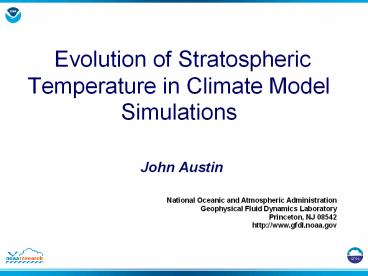Evolution of Stratospheric Temperature in Climate Model Simulations PowerPoint PPT Presentation
Title: Evolution of Stratospheric Temperature in Climate Model Simulations
1
Evolution of Stratospheric Temperature in
Climate Model Simulations
- John Austin
2
CCMval Description and runs
- Coupled chemistry-climate model simulations
- Uniform, observed forcings (solar, GHGs,
aerosols, SSTs/sea ice). - 12 different models complete climate models
with reasonably complete stratospheric chemistry. - Some runs have simplified tropospheric chemistry
- Some runs include several ensembles
- Period covered 1960-2050 mostly.
- Eyring et al. JGR, submitted.
3
(No Transcript)
4
Climatology of the final warming (S)
5
Monthly mean 50 hPa T
6
100 hPa seasonal variation
7
AMTRAC Description and runs
- GFDL climate model, coupled chemistry
- 48L model, upper boundary 0.002 hPa
- Horizontal resolution 2 x 2.5 deg.
- Finite Volume dynamical core
- Comprehensive stratospheric chemistry
simplified tropospheric chemistry - 3 member ensemble
- (1) 1960-2005 with observed forcings
- (2) 1990-2100 with A1B etc. forcings and SSTs
from GFDL IPCC runs.
8
(No Transcript)
9
Observed ozone trend
10
(No Transcript)
11
(No Transcript)
12
(No Transcript)
13
Temperature solar cycle
14
Ozone solar cycle
15
(No Transcript)
16
(No Transcript)
17
(No Transcript)
18
(No Transcript)
19
(No Transcript)
20
SOCOL MSU-4 equivalent temperature(25 months
running mean) courtesy Schnadt et al.
21
Conclusions
- Past T trends are in reasonable agreement with
observations for the period 1980-2000 in the
lower and upper stratosphere. - A solar cycle in T occurs in model results, but
is smaller than the SSU solar cycle. - In the global average, the lower stratosphere
temperature evolution agrees well with
observations. - Tropopause T decreases 1960-2005 (0.16 K/decade)
and increases thereafter (not shown) at 0.23
K/decade. - Much work is yet to be done within CCMval and on
individual models.
PowerShow.com is a leading presentation sharing website. It has millions of presentations already uploaded and available with 1,000s more being uploaded by its users every day. Whatever your area of interest, here you’ll be able to find and view presentations you’ll love and possibly download. And, best of all, it is completely free and easy to use.
You might even have a presentation you’d like to share with others. If so, just upload it to PowerShow.com. We’ll convert it to an HTML5 slideshow that includes all the media types you’ve already added: audio, video, music, pictures, animations and transition effects. Then you can share it with your target audience as well as PowerShow.com’s millions of monthly visitors. And, again, it’s all free.
About the Developers
PowerShow.com is brought to you by CrystalGraphics, the award-winning developer and market-leading publisher of rich-media enhancement products for presentations. Our product offerings include millions of PowerPoint templates, diagrams, animated 3D characters and more.

